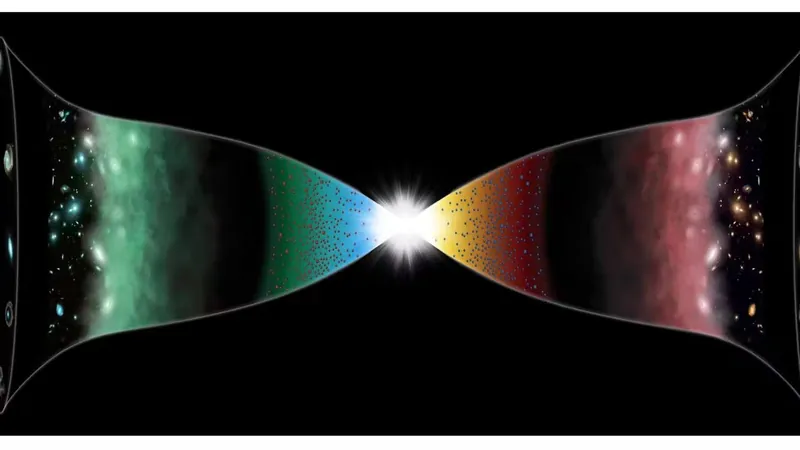
Did the Early Universe Really Expand Like a Balloon? A New Perspective Suggests a Simpler Solution!
2024-11-03
Author: Ling
We are currently living in a remarkable time for cosmic exploration. Our advanced telescopes have unveiled a universe that, surprisingly, appears to be simpler than previously thought, both on vast scales and at the smallest particle levels. This has led scientists to question the widely accepted theories that have shaped our understanding of the cosmos.
Historically, the dominant narrative in theoretical physics has centered around two main ideas: string theory and cosmic inflation. String theory postulates that the universe is composed of tiny, vibrating strings and loops, necessitating additional unseen dimensions of space. Although it offers a fascinating framework, string theory has yet to produce reliable physical predictions, making it difficult to test.
On the other hand, cosmic inflation proposes that the universe experienced a tremendous, rapid expansion during its infancy, smoothing out initial irregularities and producing the flat and homogenous cosmos we observe today. This scenario, while popular and theoretically appealing, faces challenges as recent observations continue to yield simpler explanations that contradict complex inflation models.
The disconnect between observational data and predictions suggests that perhaps our universe is fundamentally more predictable than many theorists believe. Instead of gravitating toward a complex multiverse with infinite variations, we might be overlooking simpler solutions to cosmic mysteries.
Moreover, theorists have become increasingly skeptical of string theory and inflation, as experimental evidence supporting these models continues to dwindle. For example, the rapid expansion predicted by inflation is supposed to create long-wavelength gravitational waves which have yet to be observed, leading to the rejection of many inflationary models.
In an intriguing new approach, physicists Latham Boyle and Neil Turok propose a theory that eliminates the need for both inflation and string theory. Their innovative work reframes the concept of the universe’s origin, envisioning the initial singularity — the point before the Big Bang — as a "mirror." Instead of considering the Big Bang as a singular point of creation, this theory suggests it could be connected to a pre-existing universe, where time flows in reverse.
Notably, this "mirror universe" hypothesis not only elegantly resolves various puzzles concerning time and symmetry in physics but also provides a compelling context for elusive dark matter particles. Transitioning to the concept of neutrinos, the theorists suggest that stable right-handed neutrinos, inferred from their left-handed counterparts, could serve as dark matter candidates. Importantly, their theory predicts that one of the known neutrinos must be massless – a statement currently under investigation in large-scale galaxy surveys.
Further exploration of this mirror hypothesis has led to significant insights regarding the universe's uniformity and flatness. Boyle and Turok applied statistical physics and symmetry principles to deduce that a universe with the highest entropy (in other words, the most likely configuration) is indeed flat and experiences accelerated expansion, aligning perfectly with observations of our cosmos.
They also found that certain quantum fields could generate the density variations typically attributed to inflation, thereby challenging the necessity for that theory.
Their findings highlight a pioneering path forward for cosmology, suggesting that by embracing simplicity and rigor in our theoretical frameworks, we can deepen our understanding of the cosmos.
As we continue to unravel the universe's complexities, it becomes ever more apparent that we might just be on the cusp of groundbreaking discoveries that challenge conventional wisdom in physics, providing new insights into the fundamental nature of existence itself.
In conclusion, while safe predictions offered by string theory and cosmic inflation used to dominate the discussion, the winds of change are blowing through theoretical physics. The new modeling and theoretical frameworks proposed by Boyle and Turok signify that sometimes, the answers we seek may not lie in the complex, but rather in the elegantly simple solutions. Could this be the breakthrough that reshapes our understanding of the universe? Only time will tell!

 Brasil (PT)
Brasil (PT)
 Canada (EN)
Canada (EN)
 Chile (ES)
Chile (ES)
 Česko (CS)
Česko (CS)
 대한민국 (KO)
대한민국 (KO)
 España (ES)
España (ES)
 France (FR)
France (FR)
 Hong Kong (EN)
Hong Kong (EN)
 Italia (IT)
Italia (IT)
 日本 (JA)
日本 (JA)
 Magyarország (HU)
Magyarország (HU)
 Norge (NO)
Norge (NO)
 Polska (PL)
Polska (PL)
 Schweiz (DE)
Schweiz (DE)
 Singapore (EN)
Singapore (EN)
 Sverige (SV)
Sverige (SV)
 Suomi (FI)
Suomi (FI)
 Türkiye (TR)
Türkiye (TR)
 الإمارات العربية المتحدة (AR)
الإمارات العربية المتحدة (AR)